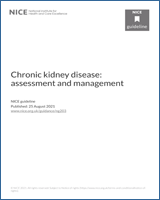Excerpt
Anaemia is defined internationally as a state in which the quality and/or quantity of circulating red blood cells is below normal. Blood haemoglobin (Hb) concentration serves as the key indicator for anaemia because it can be measured directly and has an international standard. In response to low tissue oxygen levels in anaemia the kidney produces the hormone erythropoietin which stimulates the bone marrow to produce red blood cells. A major cause of the anaemia of chronic kidney disease (CKD) is a reduction in erythropoietin production due to kidney damage.
Why is anaemia important in patients with chronic kidney disease? Possible adverse effects of anaemia include reduced oxygen utilisation, increased cardiac output and left ventricular hypertrophy, reduced cognition and concentration, reduced libido and reduced immune responsiveness.
This guideline covers the management of anaemia in adults, children and young people with a clinical diagnosis of anaemia associated with CKD. It does not cover people with anaemia not principally caused by CKD. All parts of the care pathway are covered in the guideline. The guideline development group for this 2015 update considered the evidence in several areas that provide challenges for clinicians managing the anaemia of CKD. Recombinant human erythropoietin (also called ‘EPO’, or an erythropoietic stimulating agent or ESA) for treating anaemia of CKD provides a key tool in managing the anaemia of CKD. Some CKD patients with anaemia who are receiving an ESA are ‘ESA resistant’ – that is, their condition consistently fails to respond to the effects of the ESA. Patients with such a condition often receive large doses of ESA with or without blood transfusions, with limited benefits and at significant cost to healthcare. Many CKD patients receiving an ESA are admitted with an intercurrent illness – such as pneumonia – which may temporarily render them acutely hyporesponsive to that ESA. There is uncertainty about the management of these groups of patients, and these areas were considered in the update. The often limited trial evidence in nephrology, compared to other specialities, was again highlighted.
Over the past decade or more, attention has shifted to the role and management of iron deficiency in anaemia of CKD. In CKD patients there is often a complex inflammatory state which renders the diagnosis of iron deficiency difficult when using its standard markers, such as serum iron, serum total iron binding capacity or ferritin. In recent years evidence has been published on newer markers of iron deficiency and intravenous iron preparations. In this 2015 update, the guideline development group reassessed the diagnosis and management of iron deficiency in CKD, and made several recommendations in these areas.
This is a partial update of the 2011 clinical guideline on Anaemia Management in Chronic Kidney Disease. The sections new or updated in 2015 are: Guideline development group and scope; Methodology; Diagnostic tests for the prediction of response to iron therapy; Concurrent illness; Iron therapies; Treatment of ESA resistance. All other sections and recommendations from the 2011 guideline remain unchanged. The content of other sections has not been amended and we have integrated these new sections into the relevant chapters of the old publication. This has inevitably led to inconsistencies in style of write up for reviews.


